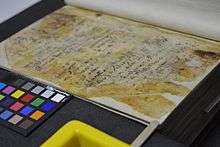Fragment on the Arab Conquests
Fragment on the Arab Conquests are fragmentary notes that were written around the year 636 AD on the front blank pages of a sixth-century Syriac Christian Gospel manuscript which depict events from the early seventh century conflict between the Byzantines and what the Fragments call "the Arabs of Muhammad" and particularly of the battle of Yarmouk.[1]
Fragments
- In January the people of Homs took the word for their lives and many villages were ravaged by the killing of the Arabs of Muhammad (Muhmd) and many people were slain and taken prisoner from Galilee as far as Beth.[2]
 BL ADD 14,461
BL ADD 14,461
- On the twenty-sixth of May the Saqilara went . . . from the vicinity of Homs and the Romans chased them . . ..
- On the tenth of August the Romans fled from the vicinity of Damascus and there were killed many people, some ten thousand. And at the turn of the year the Romans came. On the twentieth of August in the year nine hundred and forty-seven there gathered in Gabitha a multitude of the Romans, and many people of the Romans were killed, some fifty thousand.[3]
Analysis
The fragments are believed to be contemporary to the events of the Arab conquest of the early 7th century [4] They also provide one of the earlier date for the battle of Yarmuk as having taken place on 20 August 636, assuming Yarmouk is to be identified with the "battle of Gabitha" mentioned in the fragments.[5] According to Cook and Crone in Hagarism: The Making of the Islamic World, the fragments contradict the Muslim accounts of the date of death of Muhammad, alluding to him still being alive in 636 at the battle of Yarmouk.[6]
See also
References
- ↑ Robert Hoyland Seeing Islam as Others Saw It p 116 "On the front fly-leaf of a sixth-century Syriac manuscript containing the Gospel according to Matthew and the Gospel according to Mark are scribbled a few lines about the Arab conquest, now very faint."
- ↑ Possibly Bethel.
- ↑ Robert Hoyland, Seeing Islam as Others Saw It, p 116
- ↑ Robert Hoyland, Seeing Islam as Others Saw It, p 117 "Wright, the first to draw attention to the fragment, wrote that 'it seems to be a nearly contemporary notice,' a view to which Nöldeke also subscribed."
- ↑ Robert Hoyland, Seeing Islam as Others Saw It, p 117 "It is of some significance that the fragment accords with one of the dates given in Arabic sources for the battle at Gabitha (assuming this is to be identified with Yarmuk), namely 20 August AG 947/12 Rajab AH 15 (636)"
- ↑ Patricia Crone, Michael Cook, Hagarism: The Making of the Islamic World